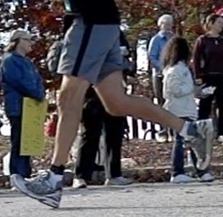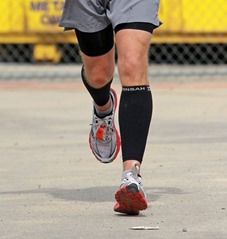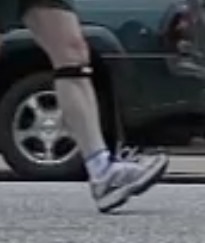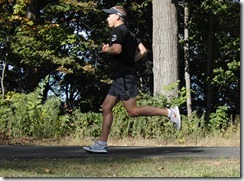 We humans like tidy little categories. With running shoes we like to take the diversity of options out there and categorize things as neutral, stability, motion control, lightweight, minimal, etc. without considering that shoes within each category are sometimes so variable as to make the category as a whole meaningless. For example, the business world includes both the Nike Free Run+ 5.0 and the Vibram Fivefingers in the same category (minimal/barefoot), which makes little sense either structurally or functionally (it’s a marketing category if anything).
We humans like tidy little categories. With running shoes we like to take the diversity of options out there and categorize things as neutral, stability, motion control, lightweight, minimal, etc. without considering that shoes within each category are sometimes so variable as to make the category as a whole meaningless. For example, the business world includes both the Nike Free Run+ 5.0 and the Vibram Fivefingers in the same category (minimal/barefoot), which makes little sense either structurally or functionally (it’s a marketing category if anything).
The same approach is applied to the running foot strike – we classify foot strikes as forefoot, midfoot, or heel, but the reality is that there is a huge amount of variation within each of these categories. For example, some forefoot strikers bring the heel down after contact, others don’t. The distance of the foot from the center of mass at initial contact varies. Joint angles vary.
I’ve long said that all heel strikes are not created equal. Some people land with the foot angled 45 degrees to the sky with a virtually locked knee, others touch down just slightly back toward the heel with a more or less vertical shin. There are lots of variants in between.
Below is a photo compilation of foot strike variation from slow motion video (300 fps) that I shot at the 2009 Manchester City Marathon. You can see variation from heel strike down to midfoot as you look from top to bottom (I trimmed off the forefoot strikers to reduce the image size) – all are at the first moment of foot contact with the ground:
What you can see above is a lot of variation in foot dorsiflexion at contact, shin orientation, knee angles, and so on.
What we’ve lacked until now is a good sense of how the different flavors of heel strike differ in terms of the way forces experience during running. I was reading through a summary of studies to be presented at the upcoming ACSM meeting on Steve Magness’ blog (great post, check it out here) and came across a study titled “Influence of Different Rear Foot Strike Strategies on Impact Force During Running.” This study was conducted by John Mercer and Sarah Horsch at UNLV – it is currently only an abstract, so one must keep that in mind, it has not been published in a journal yet.
What Mercer and Horsch did was instruct runners to run over a force plate with either “an obvious heel strike (OHS) or subtle heel strike (SHS).” Instantaneously forced stride change studies like this need to be interpreted with caution, but what they found was that at a constant speed the runners exhibited an impact force in both conditions about 85% of the time, but that impact force was significantly higher in the obvious heel strike condition (1.68±0.54 BW for OHS vs. 1.55±0.44 BW for SHS; p<0.05). They conclude that “The unique observation of this study was that impact force was influenced by foot strike patterns that would both have been considered rear foot strike patterns.”
The significance here is that it shows that impact force can vary significantly even within a single foot strike category. You might look at the heel striking data and say “Well, forefoot strikers usually have no impact, so that must be the way to go.” Not necessarily. In a study where runners were told to forefoot strike without letting the heel come down, their tibial acceleration was actually higher than when they landed on their heels (study PDF here). Jay Dicharry often makes the point that in his clinic he sees forefoot runners with high impact, and heel strikers with low impact. And, another Abstract from the ACSM meeting reports no difference in self-reported injury rates between confirmed heel-striking and non-heel-striking US Army soldiers. This contrasts with an earlier finding that forefoot-striking Harvard runners were less prone to injury.
So even among forefoot strikers there is variation, and we have no consistent and conclusive evidence that one foot strike type is better than another from an injury prevention standpoint. What’s more, we really have no idea at what magnitude impact force becomes a problem. In fact impact force magnitude has not reliably been linked to injury as far as I’m aware. Rather, impact loading rate, which is the speed at which the force is applied, has been linked to stress fracture risk. Mercer an Horsch did not report on loading rates in their abstract. It might actually be the case that some impact is a good thing for stimulating bone strength via remodeling.
So, the point I’m trying to make here is that saying “heel striking is bad” makes little sense since foot strike categories encompass a lot of variation. Some kinds of heel striking might be bad, other kinds might be just fine. You could be a forefoot striker and be exposing your tibia to more shock than if you were heel striking. There’s more to the running stride than simply which part of the foot first contacts the ground, and this is why I’ve moved away from focusing on foot strike except in certain very specific cases (e.g., I think a forefoot strike might help runners suffering from anterior compartment syndrome or chronic anterior shin splints).
As always, things are more complicated than a one size fits all prescription. Each individual is a bit different and needs to be handled accordingly.
(If you’re interested in a drier take on foot strike by me, here’s an article I wrote for Lower Extremity Review)



















Your comment about liking “tidy little” categories Pete, is spot on. Even in my world of biostatistics, people tend to like to categorize data.
This is highly problematic when one is analyzing data that are continuous and people apply largely arbitrary cutpoints to the variable. Examples would be age in decades, age >=65, BMI >30, LDL cholesterol >160, etc. We separate observations just on either side of the cutpoint into different groups and observations at the high/low extremes of a given group are lumped together.
Nature and human biology know nothing of such cutpoints. There are also likely to be confounding issues that are not correctly considered (eg. variations in biomechanics). Such categorizations are human intellectual contrivances used for convenience and do not reflect the reality that these are continuous data and the relationships to some outcome of interest (in the case of your post, to the risk of injury) are not likely to be linear (straight-line). They are likely to be curvilinear (eg. a polynomial function). Arbitrary cutpoints ignore this for the sake of simplification and so we get biased impressions and over-generalizations as a result.
Thanks for the post!
Thanks for this important column. One thing about heel strike photos vs reality (and you’ve no doubt addressed this elsewhere in your writings): In a shoe with high heel stack, which most of those in the photos appear to be, the point of shoe heel outsole strike is not the same as actual heel strike. The shoe heel starts to compress well before the actual foot heel reaches the point of full force. The process of foot strike is not a point in time; it’s a process in which the foot “rolls through” contact with the road. What looks like a dramatic, heavy heel strike might be more of a moderate or light heel strike depending on the individual runner’s dynamics.
Sorry to be the nitpicker but the sentence : “In a study where runners were told to heel strike without letting the heel come down…” makes little sense.
Interesting article. I think it’s always important to let individuals do what works for them and not force some kind magical solution on everyone.
My knees hurt from seeing all those pics though.
Good catch, that should have read “forefoot strike without letting the heel come down.” I fixed it.
—-
Pete Larson’s Web Links:
-My book: Tread Lightly: link to ow.ly
-Blog: https://runblogger.com
-Twitter: link to twitter.com
-Facebook Page: link to facebook.com…
-Discussion Forum: https://runblogger.com/forum
Meh, I like not being in pain, so I’m gonna keep training in my flat little shoes. Maybe my muscles are working harder, but my joints don’t hurt.
That’s the point, you find what works and go with it. I like my flat shoes too.
—-
Pete Larson’s Web Links:
-My book: Tread Lightly: link to ow.ly
-Blog: https://runblogger.com
-Twitter: link to twitter.com
-Facebook Page: link to facebook.com…
-Discussion Forum: https://runblogger.com/forum
The slight danger with posts like this is that it may give some people the idea they should just do whatever comes”naturally” to them. That’s not gonna work too well for people with no athletic background, like me. Even slapping some minimal shoes like Instincts or Kinvaras on them and telling them to up their cadence and shorten their stride might not work that well. I didn’t start to get it until I took my shoes off, marched in place to get those feet pointed forward symmetrically, and then ran barefoot a bit. It’s very easy to lose the feeling, so wearing pancake flat shoes like the Samson/Delilah seems to reinforce good habits. I don’t think I’m some special case. I’ll bet many beginners could benefit from this approach. And I bet they would have more long-term success than if they are led to believe that their natural approach is fine and they should just stick with it. I know that’s not your intent, but the trend seems to be towards “minimalism and barefoot running is bunk” and that’s just not true.
I’m certainly not saying it’s bunk, it’s just an option that may be good for some and unnecessary for others. I think a solitary focus on footstrike is a problem, and there are better ways to approach form change. The problem is that too many people have made this all about foot strike, and that’s a mistake.
—-
Pete Larson’s Web Links:
-My book: Tread Lightly: link to ow.ly
-Blog: https://runblogger.com
-Twitter: link to twitter.com
-Facebook Page: link to facebook.com…
-Discussion Forum: https://runblogger.com/forum
I keep beating around the bush, but what my previous comments are getting at is that if you do what I talk about, you’ll most likely end up with a forefoot strike (or sometimes midfoot, and yes, occasionally some heel striking depending on the terrain and fatigue level. But the default footstrike will tend toward forefoot). Maybe I’ll never be fast, but I just think it’s probably better than the alternative. And it just might be better for many others as well. Look at that picture at the top of the article. You can’t tell me that guy wouldn’t benefit from a little attention to form. And how many people look like that? Wearing those knee brace things and heavy shoes with all the medial posting. Crazy.
I just wonder if, in your desire to perhaps justify your own slight heel striking, you’re giving some people the impression that they should just go nuts and heelstrike all they want.
And I mean no offense. You rule!
I would agree, but again that’s my point. People with locked knee, extreme heel strikes might indeed benefit from form work or a shoe change. There is good evidence that over striding can increase load on the knee and hip. But, a mild heel strike with a landing closer to the body is probably no big deal. The point if the article is that these groups are all to often lumped together because they are all “heel strikers,” but they are probably experiencing very different force application. Focusing only on foot strike is misguided.
Sent from my iPad
Wow, just saw the PR on Twitter. Not a surprise. Must be all that heelstriking. And being on Team Bonkproof.
Thanks! Actually wound up wearing zero drop Saucony Virratas, so maybe more midfoot based on the wear pattern :)
Your accomplishments are both inspiring and daunting. Been thinking about emailing the Bonkproof guy. Sure I could use more guidance. Not gonna do it, though. I like doing it however the hell I want. For now, that’s good enough for me.
Sometimes trail and error makes the whole process more fun :)
Sent from my iPad
Great article Pete. Do you think it’s best to still attempt to transition a heel striker to a more flatfoot/fore-foot strike over time?
I would err toward working on stride length if warranted and not so much foot strike unless there is an anterior compartment issue that might be benefitted by less foot slap after heel strike. I view a range from mild heel to mild forefoot to be the range to aim for.
Sent from my iPad
Nice post.
These days, so many people chant “heel strike–Bad, forefoot strike–Good!” It’s not that simple, clearly.
By the way, I love Lower Extremity Review, especially the swimsuit issue….
I shudder just thinking about a Lower Extremity Review swimsuit issue….
Sent from my iPad
I think many are now recognizing that the shank angle is more important than the heel strike, but I do still believe that a midfoot strike allows for better energy return.
i’ve seen real heel striking, horrible…but i tend to categorize it two ways now
heel striking, and heel contact
heel contact being initial contact with the heel, but the runner’s foot still lands underneath them
most runner’s do this when fatigued, more of a natural thing
heel striking…well…don’t really need to describe it, but it looks pretty uncomfortable
I don’t believe midfoot striking exist . I think we are either forefoot striker or heel striker, that all.
Each time I land my foot on the ground, even in slow motion and in a stationary position, either the ball of my foot or my heel touch the ground first, but never both simultaneously.
IT is possible, but probably pretty rare to have a perfect midfoot strike as it implies that the ball and heel contact at the exact same time. I have seen plenty of examples on slow motion video though.
—-
Pete Larson’s Web Links:
-My book: Tread Lightly: link to ow.ly
-Blog: https://runblogger.com
-Twitter: link to twitter.com
-Facebook Page: link to facebook.com…
-Discussion Forum: https://runblogger.com/forum
I think it’s possible: link to youtube.com…
If you look attentively, in full screen resolution, his forefoot touch the ground first and then the heel after.
Anyway, not big deal. All is matter of spectrum.
Not the left.
And the same thing may be happening on the right side. It may be obscured a bit because the lateral edge towards the front of the foot may be coming into contact with the ground first, followed by the forefoot and heel simultaneously.
Ok I see. Actually, he touches the ground with the lateral edge of his feet (and then roll ) instead with the ball or with the heel.
But I guess the biggest question is probably what Pete has been getting at for a while: where does the greatest load occur? It’s probably not when that lateral edge touches, but instead later when the heel and forefoot seem to come down together. So perhaps problems arise when either the heel or forefoot bear too much of the burden at the point of greatest loading. Don’t know if my terminology is quite right, but you know what I mean.
The big issue is that the forces at impact are not nearly as big as the forces at id stance, and that is where a lot of the debate lies. There are some who think impact forces play very little role in injury, and they have only been linked to stress fracture. What happens at mid-stance when the weight of your body is bearing down on your leg is when the high forces occur and likely the source of a lot of the troubles we have.
—-
Pete Larson’s Web Links:
-My book: Tread Lightly: link to ow.ly
-Blog: https://runblogger.com
-Twitter: link to twitter.com
-Facebook Page: link to facebook.com…
-Discussion Forum: https://runblogger.com/forum
The amount of load has also lot to do with how high you “jump” and what is your landing deceleration rate. I’m curious to know what is the injury rate of “gazelle” style runners vs glider style runners.
link to youtube.com…
I was noticing that in the race I just ran – some really bouncy runners out there. I’m definitely a glider.
Sent from my iPad
The amount of load has also lot to do with how high you “jump” and what is your landing deceleration rate. I’m curious to know what is the injury rate of “gazelle” style runners vs glider style runners.
link to youtube.com…
Sweet video, thanks for linking. Certainly a discrepancy between people’s forms that I’ve noticed running with people. (II believe ‘m usually “gazelle,” unless it’s a recovery day, in which case I err more on the side of “gliding.”) One thing to be aware of though is that even here there’s no line that can separate “gazelles” versus “gliders,” and many people will fall somewhere in the middle such. I’d also guess that for many (most?) people, “gazelle” versus “glider” changes depending on how fast and on what terrain they’re running (same as footstrike and cadence and many other things).
Pete, have hear this gadget ?
link to technabob.com…
link to ellurezion.com…
I really like to try this to figure out how is my foot pressure distribution while I’m running.
That’s the first I’ve seen of that, looks interesting! I ran on a force plate treadmill a few months ago – although my initial contact is slightly toward the heel, my pressure profile is that of a midfoot strike.
Sent from my iPad
if you have no injuries/pains and do healstrike …then no issue….keep going
But if you do heel strike and have injuries/pains …cannot run every day …then its time to think about a real rootcause.
in my case it was runing technique and the change from heal to forefoot was the 1st step to “injury free” technique
This is pretty much my philosophy – if running well, no injuries, then keep doing what you’re doing. If injured frequently, time to try a change.
Sent from my iPad
I just discovered your site and am looking forward to following your posts. Really great post here. I’d just been watching a bunch of clips of some elite runners from the past and expected all to be mid- or forefoot strikers. Not so. Joan Benoit Samuelson was clearly a heel striker and, though it was harder to tell due to poor footage with Grete Waitz, she also looked to be a heel striker. I’m just getting back to running after a long hiatus (a few decades) so this is great information to have as I work my way back. At this point, posture, toe spread and breathing seem like the most important things to pay attention to…
Posture and don’t over stride are key in my opinion. Think vertical shin on contact.
Sent from my iPad
Thanks, Pete. Really helpful.
I loved this post! – I have a PT clinic and I have so many runners thinking they have to change their form- ( some that are obvious over-striders do ,but not all ) This was great. I’m doing more video analysis after taking the Running Medicine Course in VA, but am choosing to video outside -not on the treadmill. Where do you stand on this?
I prefer outside whenever possible, I’ve met people at the track a few times to do form filming. Best footage I’ve ever recorded was from a car driving alongside a runner (I wasn’t driving!)
Sent from my iPad
Pete, I enjoyed this column as I am a light heel striker working to transition to a midfoot strike. I am a walker though, not a runner. I am just starting down the minimalist trail and now wonder how this applies to walking. I am big guy at 265lbs, down from 290. Do I need to change my strike to midfoot or just continue to slowly transition into my minimalist shoes, Saucony Virratas, to strengthen my foot so it can work naturally?
Heel toe is the normal walking gait, so I would not worry about altering foot strike. Thanks for reading!
It looks like many of those runners in the heel strike photos are overstriding. I know Pete has written that overstriding “is the evil we are trying to correct by manipulating cadence”. I’m interested in whether working on hip strength and flexibility to increase stride length while holding down stride rate is smart or not. Perhaps looking at something as simple as the stride rate-to-stride length ratios among runners of varying abilities will tell the tale.
I like to say I was a forefoot runner before forefoot/midfoot or barefoot running was cool.
If you look at the shock that the body absorbs going from forefoot to heal striking, you can see that when you’re doing a forefoot strike your calf muscle absorbs a lot of the shock. When you straighten your leg, which is more typical of a heel striker, your knee takes a lot of the shock. It’s simple mechanics.
Now the advantage of heel striking is, since less calf muscle is involved as much, the body can go further without fatigue and use less oxygen per foot strike.
IMO for longevity a forefoot/midfoot strike is better on the knee and will usually make for a longer lifespan of running.
From my own observations, I believe my 40 years of running with minimal injury or downtime is due to my forefoot type running style. I also believe that I would probably be a better marathoner if I had adopted a heal strike running pattern.
Cheers
Tom
EndTheTrendNow.com
I pretty much agree with all that you write here. Well said.